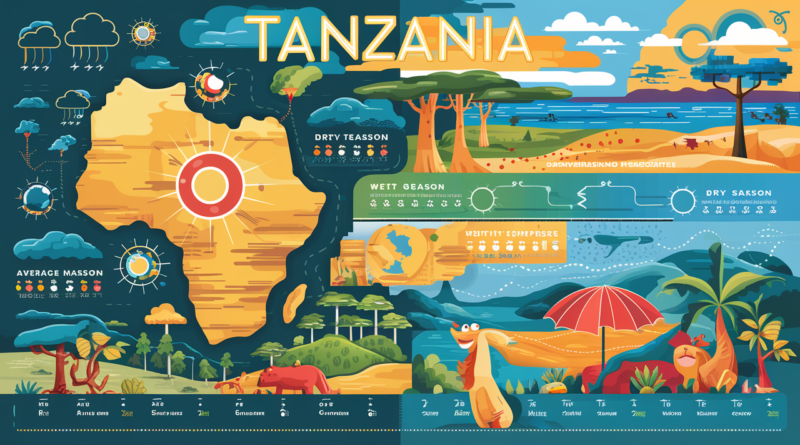Weather in Tanzania: Climate, Seasons, and Average Monthly Temperature
Tanzania, nestled in East Africa, boasts diverse landscapes, from the towering heights of Mount Kilimanjaro to the sun-drenched shores of Zanzibar. Its climate varies widely due to its size and geography, ranging from coastal plains to inland plateaus. Understanding Tanzania’s weather patterns, seasons, and average temperatures is crucial for Tanzania exodus travelers and residents alike to plan activities and make the most of their time in this beautiful country.
Tanzania’s Climate Zones:
Tanzania experiences several climate zones, broadly categorized into coastal, highland, and inland areas.
1. Coastal Regions:
Along the eastern and southern coastlines, including Dar es Salaam and Zanzibar, Tanzania experiences a tropical climate. This region is hot and humid throughout the year, with temperatures averaging around 25-30°C (77-86°F). The coastal areas also receive significant rainfall, especially during the long rainy season from March to May and the short rainy season from October to December.
2. Highland Regions:
The highland regions, including areas around Arusha and Moshi, enjoy a more temperate climate due to their elevation. Mount Kilimanjaro, Africa’s tallest peak, experiences its own microclimate, with temperatures decreasing as elevation rises. The highlands have distinct wet and dry seasons, with cooler temperatures during the dry season from June to October and warmer temperatures during the wet season from November to May.
3. Inland Plateaus:
The central and western parts of Tanzania consist of vast inland plateaus and savannahs. These regions have a semi-arid to arid climate, characterized by hot temperatures and low rainfall. Cities like Dodoma and Mbeya experience high temperatures, often exceeding 30°C (86°F), particularly during the dry season from May to October.
Seasons in Tanzania:
Tanzania experiences four main seasons:
1. Long Rainy Season (March to May):
The long rainy season brings heavy rainfall, especially along the coast and in the highland areas. This season is essential for agriculture and replenishing water sources but can make travel and outdoor activities challenging due to muddy roads and flooding.
2. Dry Season (June to October):
The dry season is characterized by clear skies and minimal rainfall across most of Tanzania. It’s an excellent time for wildlife viewing, particularly in national parks like the Serengeti and Ngorongoro Crater, as animals gather around water sources. The temperatures are generally cooler during this period, making it ideal for outdoor adventures and trekking.
3. Short Rainy Season (October to December):
The short rainy season is less intense than the long rainy season but still brings significant rainfall to coastal and highland regions. It can disrupt travel plans and outdoor activities but also contributes to lush landscapes and vibrant flora.
4. Short Dry Season (January to February):
January and February mark a brief period of dry weather before the long rainy season begins. It’s an excellent time to visit Tanzania, with pleasant temperatures and minimal rainfall across most regions.
Average Monthly Temperatures:
Understanding the average monthly temperatures in Tanzania helps visitors and residents prepare for the climate they will encounter throughout the year. Here’s a breakdown of average temperatures across different regions and seasons:
1. Coastal Regions:
– March to May: Average temperatures range from 25°C to 30°C (77°F to 86°F), with high humidity levels and frequent rainfall.
– June to October: Temperatures remain warm, ranging from 23°C to 28°C (73°F to 82°F), with lower humidity and minimal rainfall.
– October to December: Similar temperatures to the long rainy season, with increased humidity and intermittent rainfall.
2. Highland Regions:
– March to May: Temperatures range from 15°C to 25°C (59°F to 77°F), with cooler temperatures at higher elevations and significant rainfall.
– June to October: Cooler temperatures prevail, ranging from 10°C to 20°C (50°F to 68°F), making it an ideal time for trekking and outdoor activities.
– October to December: Temperatures increase slightly, with intermittent rainfall and lush landscapes.
3. Inland Plateaus:
– March to May: Hot temperatures ranging from 25°C to 35°C (77°F to 95°F), with minimal rainfall and dry conditions.
– June to October: The dry season brings even higher temperatures, averaging 30°C to 40°C (86°F to 104°F), with clear skies and little to no rainfall.
– October to December: Temperatures remain high, with sporadic rainfall and dry conditions persisting.
Conclusion:
Tanzania’s weather varies significantly across its diverse landscapes and regions. Understanding the climate zones, seasons, and average temperatures is essential for planning travel itineraries, wildlife safaris, trekking expeditions, and cultural experiences.
Whether exploring the savannahs of the Serengeti, summiting Mount Kilimanjaro, or relaxing on the beaches of Zanzibar, Tanzania offers a wealth of natural beauty and cultural diversity. By being mindful of Tanzania’s weather patterns and seasonal changes, visitors can make the most of their time in this enchanting East African nation.




